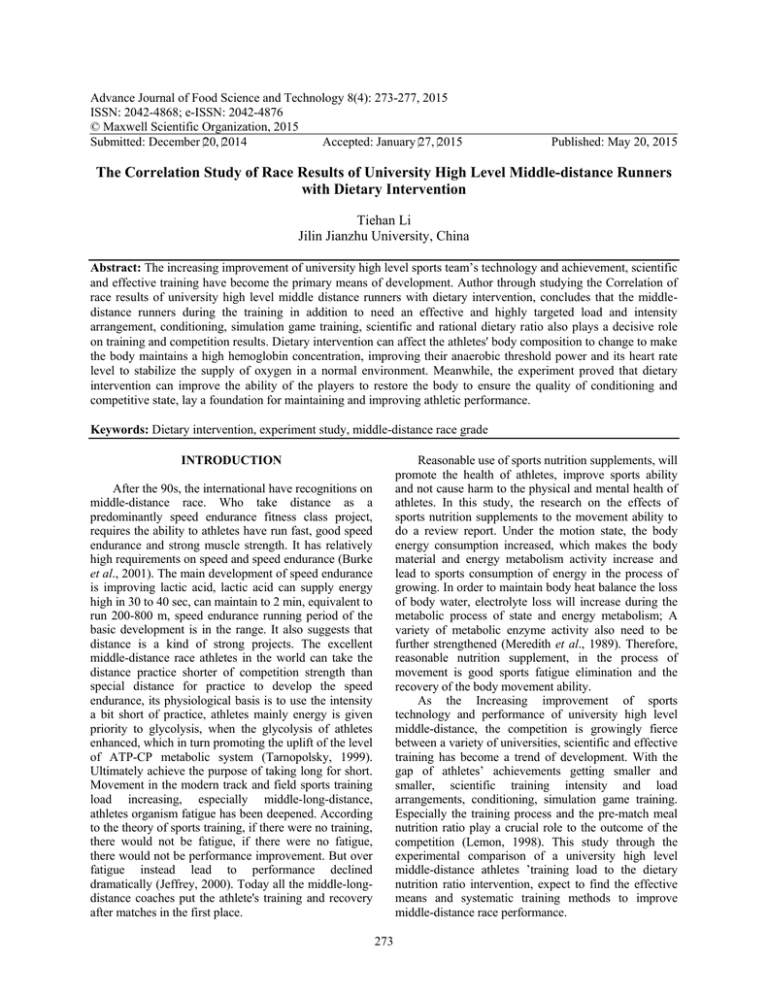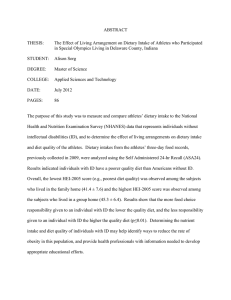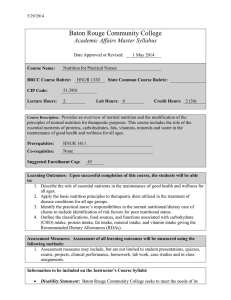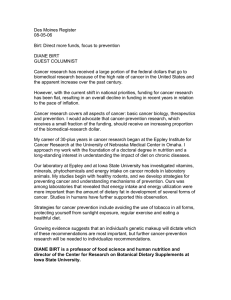Advance Journal of Food Science and Technology 8(4): 273-277, 2015
advertisement

Advance Journal of Food Science and Technology 8(4): 273-277, 2015 ISSN: 2042-4868; e-ISSN: 2042-4876 © Maxwell Scientific Organization, 2015 Submitted: December 20, 2014 Accepted: January 27, 2015 Published: May 20, 2015 The Correlation Study of Race Results of University High Level Middle-distance Runners with Dietary Intervention Tiehan Li Jilin Jianzhu University, China Abstract: The increasing improvement of university high level sports team’s technology and achievement, scientific and effective training have become the primary means of development. Author through studying the Correlation of race results of university high level middle distance runners with dietary intervention, concludes that the middledistance runners during the training in addition to need an effective and highly targeted load and intensity arrangement, conditioning, simulation game training, scientific and rational dietary ratio also plays a decisive role on training and competition results. Dietary intervention can affect the athletes' body composition to change to make the body maintains a high hemoglobin concentration, improving their anaerobic threshold power and its heart rate level to stabilize the supply of oxygen in a normal environment. Meanwhile, the experiment proved that dietary intervention can improve the ability of the players to restore the body to ensure the quality of conditioning and competitive state, lay a foundation for maintaining and improving athletic performance. Keywords: Dietary intervention, experiment study, middle-distance race grade Reasonable use of sports nutrition supplements, will promote the health of athletes, improve sports ability and not cause harm to the physical and mental health of athletes. In this study, the research on the effects of sports nutrition supplements to the movement ability to do a review report. Under the motion state, the body energy consumption increased, which makes the body material and energy metabolism activity increase and lead to sports consumption of energy in the process of growing. In order to maintain body heat balance the loss of body water, electrolyte loss will increase during the metabolic process of state and energy metabolism; A variety of metabolic enzyme activity also need to be further strengthened (Meredith et al., 1989). Therefore, reasonable nutrition supplement, in the process of movement is good sports fatigue elimination and the recovery of the body movement ability. As the Increasing improvement of sports technology and performance of university high level middle-distance, the competition is growingly fierce between a variety of universities, scientific and effective training has become a trend of development. With the gap of athletes’ achievements getting smaller and smaller, scientific training intensity and load arrangements, conditioning, simulation game training. Especially the training process and the pre-match meal nutrition ratio play a crucial role to the outcome of the competition (Lemon, 1998). This study through the experimental comparison of a university high level middle-distance athletes ’training load to the dietary nutrition ratio intervention, expect to find the effective means and systematic training methods to improve middle-distance race performance. INTRODUCTION After the 90s, the international have recognitions on middle-distance race. Who take distance as a predominantly speed endurance fitness class project, requires the ability to athletes have run fast, good speed endurance and strong muscle strength. It has relatively high requirements on speed and speed endurance (Burke et al., 2001). The main development of speed endurance is improving lactic acid, lactic acid can supply energy high in 30 to 40 sec, can maintain to 2 min, equivalent to run 200-800 m, speed endurance running period of the basic development is in the range. It also suggests that distance is a kind of strong projects. The excellent middle-distance race athletes in the world can take the distance practice shorter of competition strength than special distance for practice to develop the speed endurance, its physiological basis is to use the intensity a bit short of practice, athletes mainly energy is given priority to glycolysis, when the glycolysis of athletes enhanced, which in turn promoting the uplift of the level of ATP-CP metabolic system (Tarnopolsky, 1999). Ultimately achieve the purpose of taking long for short. Movement in the modern track and field sports training load increasing, especially middle-long-distance, athletes organism fatigue has been deepened. According to the theory of sports training, if there were no training, there would not be fatigue, if there were no fatigue, there would not be performance improvement. But over fatigue instead lead to performance declined dramatically (Jeffrey, 2000). Today all the middle-longdistance coaches put the athlete's training and recovery after matches in the first place. 273 Adv. J. Food Sci. Technol., 8(4): 273-277, 2015 athletes’ strength and physical recovery. So the key of improving the sport scores is scientific use of nutrients to supply the materials, considering the consumption of sports and to repair the damaged physical structure, to eliminate bodies’ tiredness. These results are showed in Table 1. MATERIALS AND METHODS Research subjects: Choose 14 middle/long distance runners in some university, 8 male players, 6 female players and each project has two players, which includes men 800, 1500, 5000, 10,000 and women 800, 1500, 3000 m as experimental subjects and conditions. Diet survey: Two dietary nutrition surveys are conducted to athletes on the forth week and the eighth week of the training. And the main eating style is selfservice. Weighing method is taken into uses for dietary survey. It will be weighed accurately day by day. And the various fruit and food’s raw weight before cooking and remaining amount after dinner should be recorded. Weighing and recording various fruit and food’s consumption of every athlete in each meal of three days, the daily intake of various nutrients every person, three meals calorie ratio, nutrients food sources and dietary composition are calculated by applying the athletes and the general public nutritional analysis and management system. The survey results are as follows (Loosly, 1997): Methods: The experiment time is from August of 2007 to October of 2007. It costs a total of nine weeks. The training time is twenty past six to ten past seven every morning. It will last forty to fifty minutes. And the other training time is 4 pm to 6 pm every afternoon. The time is 2 h. According to the training requirements, the experiment can be divided into the following three steps: The first step: Listing conditioning program and dietary nutrition ratio, the various nutrients ratios remain relatively fixed standard at the first five week, complying with the content, amount and intensity of the training program, all kinds of nutrition ratio from increasing the quantity gradually turn into improving the quality of nutrition and increase the quantity and quality of food at the late four weeks (Melinda et al., 2009). • The second step: Analyze the final results and discuss the correlation of dietary nutrition and sports performance by matching the dietary nutrition proportion of the fourth week and the eighth week and investigating the changes of anaerobic threshold power and its heart rate. • • • Inadequate Carbohydrates (sugars). And some of the players are lack of high quality protein. But the fat intake is very high. The allocation of three meals intake amount for some players is improper. The vitamins, inorganic salts and sugar supplement sports are inadequate. Excessive meat and less vegetables and fruit. Diet adjustment: According to the results above, several adjustments for diet have been done. These changes are listed in the following: The third step: Analyze the effects dietary intervention and dietary adjustments to athletes’ achievements by the comparison of university conditioning practice schedule in the second season, dietary nutrition proportion to the average score of the two tests after winter training and the best score in the second season. Daily staple food: 400 to 500 g (70% of rice and noodles, cereals account for 30%). Daily sugar supplement: The sugar supplement amount is 0.75 to 1g/ kg before competition in the early training. During the competition, it is from 50 to 60 g/h. After the competition, it is from 0.5 to 19/kg. And the concentration is 7 to 9%. The sugar supplement amount is 1 g/kg in the late training before the sports. And during the sports, the supplement is 60g/h. After sports, it is 1g/kg. The concentration is 10 to 12%. Relative analysis of sports score and dietary nutrition: In the modern middle-distance racing sports, the players bear an absolutely high sports load which will lead the physical, spiritual numerous consumption and increasingly exhaustion in the process of training and after competition. If the lack of nutritional supplements and restore strength will not be eliminated in time, this will influence subsequent training and competition. Therefore, eliminating tiredness after exercises is necessary for nutritional recovery which cannot be ignored. The research suggests that proportion imbalance in protein, fat, carbohydrate, vitamin and mineral in the dietary, would result in a great impact on Daily protein sources: 25 to 30 g protein powder every day for each person. The rest mainly comes from food. (500 ml milk, meat, fish, chicken and beef-based, bean products 50 to 100g every other day). Table 1: Training before race and dietary plan Weeks Training contents 6th Special quality and technology 7th Special quality and technology 8th Special technology 9th Adjustment before race Quantity Medium and large Small Small Medium 274 Intensity Small Medium Medium Large Adv. J. Food Sci. Technol., 8(4): 273-277, 2015 Mineral salt supplement in daily exercise: In the early training, players take sports drinks after sports and electrolyte capsules. Then, the amount can be reduced 1 to 2 tablets every day in the late training. From the Table 3, it can be seen that the intakes of calcium, potassium and zinc are deficient. And the ratio between calcium and phosphorus is l:2.21. Both of them are a little low. After nutrition intervention, calcium and potassium is more than 90% of the recommended amount. And the calcium and phosphorus ratio is 1: l.08. The zinc intake is less than 85% of the recommended amount before nutrition intervention. It shows that athletes’ three main heat energy nutrients supplement proportion and every meal’s energy supplement proportion are within the normal range and the vitamin A, C, B1 and calcium intake amount reaches the above 89% of recommended amount by adjusting the diet structure and strengthening nutritional supplements. The remaining problem is that the intake of dinner and evening snacks is relatively high and zinc intake is below the recommended amount, etc. It can be seen from Table 4 that vitamin A, C, B1 are lower than 60% of the recommended amount before nutrition intervention and vitamin groups are higher Daily fruits and vegetables intake amount: Daily intake is form 600 to 800g every day. And according to the situation, the green vegetables are the main food. ANALYSIS AND DISCUSSION Analysis: As is shown in Table 2, according to the athlete dietary nutrition before nutrition intervention, the survey finds that the intake amount of carbohydrates, protein and total calorie are lower than 90% of the recommended amounts. And the fat intake in lunch is a little high as well as that in dinner. It is found that carbohydrates, protein and total calorie intake are up to more than 95% of the recommended amounts. And the fat energy proportion in dinner is in a reasonable range by surveying athletes’ dietary nutrition after using high energy drinks. Table 2: The main three energy nutrients, heat and energy supplement condition of every meal The first research (4th week) The first research (8th week) -------------------------------------------------------------------------------------------------------------------------------------Intake amount Intake amount Intake amount Intake amount % Total Calorie (kcal) 3855.8 81.8 4572.6 ▲ 101.4 Protein 128.7 81.3 138.0▲ 92.9 Fat 133.3 110.1▲ Carbo-hydrates 465.3 85.4 677.8▲ 123.7 Proportion (Protein, fat, 12.3:32.6:48.4 11.8:22.5:59.2 carbo-hydrates) Proportion (Lunch, 26.0:38:1:27.0:9.9 27.1:35.5:29.1:10.3 dinner, snacks) ▲: There is a significant difference between the first diet and the second one (p<0.05) Table 3: The daily average intake of inorganic salt The first research (4th week) ------------------------------------------------------------------Inorganic salt (mg) Intake amount Intake amount/recommended Sodium 4521.1 Potassium 2894.9 81.10 Iron 33.100 133.0 Calcium 742.20 76.00 Magnesium 454.70 118.5 Phosphorus 1673.4 Zinc 17.600 88.80 Copper 1.3000 Manganese 6.0000 Selenium 107.80 233.8 ▲: There is a significant difference the first diet compared to the second one (p<0.05) The first research (8th week) ------------------------------------------------------------------Intake amount Intake amount/recommended 4578.9 3426.5▲ 98.30 46.3▲ 145.8 1559.3▲ 92.70 495.70 128.7 1706.1 16.600 83.80 2.0000 6.4000 106.20 232.2 Table 4: The daily average intake of vitamins The first research (4th week) ------------------------------------------------------------------Intake amount Intake amount/recommended Vitamins (mg) Vitamin A (RE) 850.7 57.8 Vitamin E (mg) 66.9 Vitamin C (mg) 90.2 49.9 Vitamin B1 (mg) 1.60 59.8 Vitamin B2 (mg) 3.00 159.8 Vitamin PP (mg) 38.2 191.8 ▲: There is a significant difference between the first diet and the second one (p<0.05) The first research (8th week) -------------------------------------------------------------------Intake amount Intake amount/recommended 1756.3 ▲ 118.2 74.900 244.6▲ 127.1 4.3▲ 149.8 5.1▲ 264.8 59.3 297.3 275 Adv. J. Food Sci. Technol., 8(4): 273-277, 2015 Table 5: Training before race and dietary plan Weeks Anaerobic threshold power Anaerobic threshold heart rate Early march (at the end of winter training) 258.9±22.3 159.3±3.0 The 1st week 215.6±13.7▲ 152.7±5.5▲ The 5th week 239.9±16.2● 142.9±10.8● The 9th week 252.8±10.3● 146.6±6.9▲ ▲: Compared to anaerobic threshold power, there is a significant difference and its heart rate in winter training (p<0.05); ●: There is a significant difference compared to one week’s anaerobic threshold power and its heart rate (p<0.05) Table 6: The comparison of men group’s best average score to those of women group Project The best score The first test score Men's 800 m 1:53.500 1:55.90 0 Women's 800 m 2:13.400 2:14.20 0 Men's 1500 m 3:54.000 3:55.40 0 Women's 1500 m 4:32.000 4:35.60 0 Men's 5000 m 14:28.00 15:50.00 Women's 3000 m 9:55.000 10:05.00 Men's 1000 m 33:50.00 34:06.00 than above 100% of the recommended amount after nutrition intervention. The second test score 1:54.400 2:12.400 3:52.600 4:32.200 14:30.00 9:59.00 0 33:40.00 The best score during race 1:52.500 2:10.100 3:51.800 4:28.600 14:25.00 9:54.000 33:28.00 effect gradually improved, training indicators had reached the requirements, nutrition and function condition are fine in late 5th to 9th weeks. This proved that nutrition interventions received effectiveness and ensured players’ quality training and competitive state. As is shown in Table 5, the team average anaerobic threshold power significantly decreased 43.3 watts, reduced 16.72% (p<0.05). The team average anaerobic threshold heart rate decreased 6.6 times, reduced 4.14% (p<0.05) at the beginning of the training compared to those of the end of the winter training. The team average anaerobic threshold power dropped 6.1 watts, reduced 2.36% at the ninth week compared to the end of this winter training, this difference was not obvious. The team average anaerobic threshold power reduced 12.7 times, decreased 7.97% (p<0.05). It suggested that players ’aerobic capacity decreased significantly after the training. Then it would have an impact on athletes’ special endurance training. We found the power increased by testing the players’ average anaerobic threshold power in whole training, the average anaerobic threshold heart rate firstly decreased and then increased. The team average anaerobic threshold power respectively rose 24.3 watts and 37.2 watts,rose10.13% (p<0.05) and 14.71% (p<0.05), the whole team’s average anaerobic threshold heart rate respectively dropped 9.8 times and 6.1 times, decreased 6.42% (p<0.05) and 3.99% at the fifth week and the ninth week compared to those of the before training (the first week). It shows that the players’ aerobic capacity increase steadily and recover to the level of winter training as well as improve heart function, enhanced the players’ abilities of special endurance training and load endurance by training to enhance Aerobic abilities. The effect of training and nutrition intervention: The effective method that improves the athlete's anaerobic threshold power is to ensure the quality of aerobic training. According to the nutrition and human sports science theory, sufficient energy supplement, especially carbohydrates, higher hemoglobin concentration as well as stable normal interior environment, are all the basic protection for aerobic exercise. By adjusting the dietary structure, supplying sugar before, during and after competition and using the iron, medicine and other nutrition products conducive to improve hemoglobin, a systematic aerobic training’s material basis is ensured so that achieving the training program proceed smoothly. Although the training load and the amount of movement are relatively large at the 7th and 9th weeks, the training effects of players in exercise are gradually improved, especially reaching the training requirements in late training. And nutrition and function are both in a good condition. This proves that nutrition intervention receives effectiveness and ensure the quality of training and the state before competition. Anaerobic threshold is one of the extremely effective indicators evaluated anaerobic ability of middle-distance runners which has been widely used in modern training. Studies have shown that the average players’ anaerobic threshold power and its heart rate in training before race is significantly lower than the level at the end of winter training. Throughout the pre-match training ,from 1st to 4th weeks’ training effectively improved the anaerobic threshold power and reduced the anaerobic threshold heart rate. Players’ average anaerobic power is to be restored to the level at the end of winter training in 5th to 9th weeks, however, anaerobic threshold heart rate was significantly lower than the amount at the end of winter training, the difference was not obvious, compared to the amount of training at the beginning, despite the training load was relatively large in September 8. The players training The impact of nutritional intervention: It is shown that middle and long distance project is to bring full play to the effect of nutrition in health. The diet fit for requirements must be provided to ensure players’ best physiology, training and competition condition by comparing the best score of men group to those of 276 Adv. J. Food Sci. Technol., 8(4): 273-277, 2015 women group in middle and long distance project (Table 6). The supplement principles: Firstly, complement all kinds of vitamin substances, they are all conducive to body's metabolism in varying degree. Vitamins consumption is large, so it is helpful to eliminate tiredness by replenishing more liver oil, hawthorn, fruit, green vegetables and a variety of grains. Secondly, replenish minerals promptly. Thirdly, according to the traits of endurance project, namely, long time, low strength and much consumption of thermal energy, the food including protein, vitamins, starch and sugar, such as lean meat, fish, eggs, rice, flour, maize, sorghum, beans, root foods (sweet potatoes, potatoes, carrots, etc.) and fruit, melons should be replenished so as to ensure adequate supply of dietary synthesis and eliminate fatigue after exercise. As is proved in Table 1 and 6, the team members’ ability to withstand exercise load had been significantly enhanced and sports performance steadily improving by nutritional intervention and training programs adjustment. The major players’ anaerobic threshold power of women's 1,500 m and men's 5,000 m, 10,000 meters was higher than general athletes, whereas the anaerobic threshold heart rate was low. So players sports load is larger than ordinary athletes. Men and women’s average score of different projects is increasing. And the difference of women's 80 m and 3000 m’ average scores varied widely. The sports performance is unstable and the difference of abilities remains in the same group. In addition, the athletes’ energy supplement should be particularly paid attention during the training (Table 2), especially for the long distance training of the amount of sugar in 100 to 150 g before during and after the long time. By strengthening athletes sugar supplement, it is to ensure that athletes’ glycogen reserves in training and the maintenance of blood sugar as well as changes in anaerobic threshold power and anaerobic threshold heart rate made athletes achieve training program. By comparing the average sports results, it is suggested that it would improve athlete competition scores by using of nutritional intervention and the regulation of various technical which means to players’ physiology and psychology. If we design robotic system on the basis of Table 1, the next task is how to comprehensively integrate those subsystems. Previous robot system architecture model often concentrates on smaller, areas within the field. Therefore, in this study, we provide full threedimensional integrated reference. CONCLUSION The dietary intervention to the athletes of middle and long distance is one of the effective measures to improve and ensure athletes’ competition scores which can influence and transform body’s composition and excavate players’ potential. As a high level sports team in university, comprehensive and systematic nutritional monitoring and supplement are important to achieve the scientific training, only on the basic of strengthening nutrition. Referring each player’s training load, adjusting related training indicators and effectively monitoring the training restoration can enhance race performance or make players break through their best score so that retain excellent results in major competitions. ACKNOWLEDGMENT The authors wish to thank the helpful comments and suggestions from my teachers and colleagues in intelligent detection and control lab of HIT at Weihai. And also thank Beijing Up-tech to provide part hardware. This study is supported by the study fund of HIT at Weihai (No. IMVQ02020003 and IMJQ21080002). REFERENCES Burke, L.M., G.R. Cox, N.K. Cummings and B. Desbrow, 2001. Guidelines for daily carbohydrate intake: Do athletes achieve them? Sports Med., 31: 267-299. Jeffrey, T.L., 2000. Perspectives in exercise science and sports medicine volume 12: The metabolic basis of performance in exercise and sport. Nutr. Clin. Care, 3(4): 247-248. Lemon, P.W., 1998. Effects of exercise on dietary protein requirements. Int. J. Sport Nutr., 8: 426-447. Loosly, A.R., 1997. Dietary Reference Intakes for Calcium, Phosphorus, Magnesium, Vitamin D and Fluoride. National Academy Press, Washington, DC, pp: 288-313. Melinda, M., L.M. Nanna and T. Janice, 2009. Sport Nutrition for Health and Performance. 2nd Edn., Human Kinetics, Champaign, IL. Meredith, C.N., M.J. Zackin, W.R. Frontera and W.J. Evans, 1989. Dietary protein requirements and body protein metabolism in endurance trained men. J. Appl. Physiol., 66: 2850-2856. Tarnopolsky, M., 1999. Protein metabolism in strength and endurance activities. Persp. Exer. Sci. Sport. Med., 12: 125-157. 277




